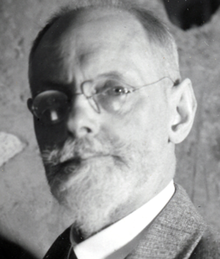Carl Wiman | |
|---|---|
 Carl Wiman in 1937, aged 70 | |
| Born | Carl Johan Josef Ernst Wiman 10 March 1867 Stockholm, Sweden |
| Died | 15 June 1944 (aged 77) Uppsala, Sweden |
| Resting place | Uppsala gamla kyrkogård[1] |
| Nationality | Swedish |
| Alma mater | Uppsala University |
| Scientific career | |
| Fields | |
| Institutions |
|
| Thesis | Über die Graptoliten (1895) |
| Doctoral advisor | Arvid Högbom |
Carl Johan Josef Ernst Wiman (March 10, 1867 – June 15, 1944) was a Swedish palaeontologist, the first professor of palaeontology and historical geology at Uppsala University, and the father of Swedish vertebrate palaeontology.[2]
Wiman was instrumental in the construction of the Palaeontological Museum of Uppsala University (now part of the Museum of Evolution), which contains the largest collection of Chinese fossil vertebrate material outside China.[2]
He is responsible for naming the genera Helopus (renamed Euhelopus because Helopus was already in use) and Tanius,[3] and the species Pentaceratops fenestratus[4] and Parasaurolophus tubicen.[5] He was also the first to suggest that the hollow cranial crests of lambeosaurine duckbill dinosaurs could be used as a horn-like noisemaker.[5]
- ^ "Wiman, Carl Johan Josef Ernst". SvenskaGravar. Retrieved 20 February 2021.
- ^ a b Ebbestad, Jan Ove R. (2016). "Carl Wiman and the foundation of Mesozoic vertebrate palaeontology in Sweden". Journal of the Geological Society. 434 (1): 15–29. Bibcode:2016GSLSP.434...15E. doi:10.1144/SP434.15. S2CID 87927197. Retrieved 14 February 2021.
- ^ Wiman, Carl (1930). "Die Kreide-Dinosaurier aus Shantung". Palaeontologia Sinica, Series C (in German). 6 (1): 1–67.
- ^ Wiman, Carl (1930). "Über Ceratopsia aus der Oberen Kreide in New Mexico". Nova Acta Regiae Societatis Scientiarum Upsaliensis. Series 4 (in German). 7 (2): 1–19.
- ^ a b Wiman, Carl (1931). "Parasaurolophus tubicen, n. sp. aus der Kreide in New Mexico". Nova Acta Regiae Societatis Scientiarum Upsaliensis. Series 4 (in German). 7 (5): 1–11.